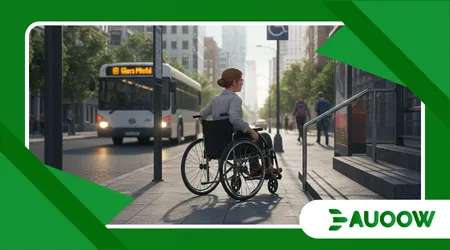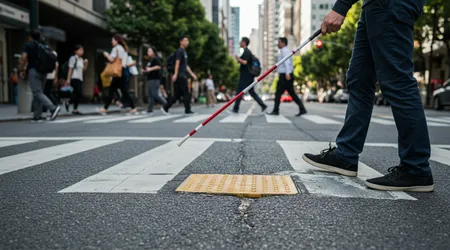How Urban Planning Policies Ignore People with Mobility Challenges

Urban planning policies ignore people with mobility challenges, sidelining millions who navigate cities designed without their needs in mind.
In 2025, as urban populations swell, the oversight persists, leaving those with disabilities physical, sensory, or cognitive struggling in environments prioritizing efficiency over inclusivity.
From uneven sidewalks to inaccessible transit, cities often fail to deliver equitable access.
This article explores the gaps in urban design, their real-world impacts, and actionable solutions, grounded in current realities and human-centered perspectives.
Why do cities, hubs of progress, still sidestep the needs of those with mobility challenges?
The answer lies in a mix of outdated priorities, budget constraints, and a lack of empathy in planning.
By examining global trends, real-life examples, and data-driven insights, we uncover how urban systems can evolve to embrace true inclusivity.
The Accessibility Gap in Urban Design
Cityscapes often reflect a bias toward able-bodied users. Urban planning policies ignore people with mobility issues by prioritizing car-centric infrastructure over pedestrian accessibility.
Sidewalks with uneven surfaces or missing ramps create daily obstacles for wheelchair users. In 2023, a UN-Habitat report noted that 40% of urban dwellers with disabilities face barriers to mobility.
Planners often retrofit accessibility features rather than embedding them from the start.
This reactive approach breeds inefficiency. For instance, in São Paulo, Brazil, a 2024 audit found only 25% of bus stops met accessibility standards.
++ Disability and Voting: Are Polling Stations Really Accessible?
Wheelchair users like Ana, a 32-year-old teacher, must detour blocks to find a usable stop. Such gaps aren’t just inconvenient they erode dignity and independence.
Neglecting accessibility also ignores economic potential.
Inclusive design boosts participation in work and social life, yet planners often view it as a cost, not an investment. This mindset perpetuates exclusion, leaving cities less vibrant for all.

Systemic Barriers in Policy Frameworks
Urban planning policies ignore people with mobility challenges through rigid frameworks that undervalue diverse needs.
Many cities follow outdated zoning laws, prioritizing commercial development over universal design. In the U.S., the Americans with Disabilities Act (ADA) sets standards, but enforcement lags.
A 2024 study showed 60% of U.S. municipalities lack consistent ADA compliance in public spaces.
Consider Tokyo, where narrow streets and crowded stations challenge those with mobility aids.
Despite Japan’s aging population, only 30% of subway stations are fully accessible in 2025. Retrofitting costs billions, proving proactive design is cheaper long-term.
Also read: Why Digital Accessibility Should Be a Legal Standard, Not an Option
Policy inertia also stems from limited stakeholder input.
People with disabilities are rarely consulted during planning phases, leading to solutions misaligned with their realities. This disconnect fosters environments that exclude rather than empower.
The Human Cost of Exclusionary Design
When urban planning policies ignore people with mobility challenges, the human toll is profound. Inaccessible spaces limit access to jobs, healthcare, and social connections.
For example, in London, a wheelchair user named James missed medical appointments due to unreliable accessible transport. Such stories highlight how design flaws disrupt lives.
Social isolation is another consequence. Inaccessible parks or public squares exclude those with mobility challenges from community life.
Read more: How Budget Cuts Are Affecting Disability Services in 2025
A 2024 UK survey found 45% of disabled individuals felt excluded from public spaces due to physical barriers.
Mental health suffers too. Constantly navigating hostile environments breeds frustration and anxiety. When cities fail to prioritize accessibility, they signal that some residents matter less, undermining social cohesion.
Economic and Social Benefits of Inclusive Planning
Embracing accessibility transforms cities. Urban planning policies ignore people with mobility challenges at the cost of economic vitality.
Inclusive design attracts diverse workers and visitors, boosting local economies. For instance, Toronto’s 2024 accessibility upgrades increased tourism revenue by 12% from disabled travelers.
Socially, inclusive spaces foster belonging. Accessible parks and transit systems enable everyone to engage in civic life.
Copenhagen’s pedestrian-friendly redesign, with ramps and tactile paving, shows how universal design benefits all, not just the disabled.
Moreover, inclusive planning aligns with sustainability goals. Accessible public transit reduces car dependency, cutting emissions.
Cities like Amsterdam prove that walkable, rollable spaces enhance both equity and environmental health.
Case Studies: Where Cities Fail and Succeed

Urban planning policies ignore people with mobility challenges in cities like Delhi, where urban sprawl outpaces accessibility upgrades.
A 2025 report found only 15% of Delhi’s metro stations offer reliable elevator access. Commuters like Priya, who uses a cane, face daily risks navigating crowded, uneven platforms.
Contrast this with Stockholm, where 80% of public transport is accessible.
The city’s 2023 mobility plan prioritized tactile paving and low-floor buses, easing navigation for all. Stockholm’s success stems from early stakeholder engagement, ensuring designs reflect real needs.
Another example is Medellín, Colombia, where cable cars connect hilly neighborhoods, making mobility easier for disabled residents.
This innovative approach shows how creative planning can bridge accessibility gaps, unlike car-centric cities that lag behind.
Policy Recommendations for Inclusive Urban Planning
To address how urban planning policies ignore people with mobility challenges, cities must act decisively.
First, integrate universal design principles into all projects from the outset. This means mandatory accessibility audits before construction begins.
Second, involve people with disabilities in planning. Cities like Seattle have advisory boards with disabled residents, ensuring policies reflect lived experiences.
Third, allocate budgets for retrofitting prioritizing high-traffic areas like transit hubs.
Finally, enforce compliance with global standards, like the UN’s Sustainable Development Goal 11. Training planners on inclusive design is crucial.
Cities must shift from viewing accessibility as optional to seeing it as a cornerstone of urban progress.
Data Snapshot: Accessibility in Urban Planning
| City | Accessible Transit (%) | Year of Data | Key Challenge |
|---|---|---|---|
| São Paulo | 25% | 2024 | Uneven sidewalks, limited bus ramps |
| Tokyo | 30% | 2025 | Narrow streets, crowded stations |
| Stockholm | 80% | 2023 | High retrofitting costs |
| Delhi | 15% | 2025 | Urban sprawl, unreliable elevators |
The Role of Technology in Bridging Gaps
Technology offers solutions where urban planning policies ignore people with mobility challenges. Smart city tools, like real-time accessibility maps, help users navigate barriers.
Apps like AccessNow, used in 35 countries by 2025, pinpoint accessible routes and facilities.
Autonomous shuttles, tested in Singapore, provide flexible transport for those with mobility issues.
However, tech isn’t a cure-all costly solutions can exclude low-income users. Planners must ensure tech complements, not replaces, physical infrastructure improvements.
Public-private partnerships can accelerate progress. In 2024, London partnered with tech firms to install smart ramps, proving scalable solutions are possible when innovation aligns with policy.
A Call for Empathy in Urban Design
Imagine navigating a city where every step is a gamble curbs too high, buses too crowded, signs unreadable.
This is the reality for millions when urban planning policies ignore people with mobility challenges. Empathy must guide design, placing human needs above expediency.
Cities like Barcelona show what’s possible, with 90% accessible metro stations in 2025.
Planners there prioritized tactile paving and audio signals, proving empathy-driven design works. Every city can learn from such models to create spaces where all thrive.
Ultimately, inclusive cities aren’t just fair they’re vibrant. By designing for everyone, we build communities that uplift, connect, and inspire, ensuring no one is left behind.
Frequently Asked Questions
Why do urban planning policies ignore people with mobility challenges?
They often prioritize cost and speed over inclusivity, with limited input from disabled communities.
How can cities improve accessibility?
Involve disabled residents in planning, enforce global standards, and integrate universal design from the start.
What’s the economic impact of inclusive design?
It boosts participation and tourism, as seen in Toronto’s 12% revenue increase from accessible upgrades.
Are there successful examples of inclusive urban planning?
Yes, Stockholm and Medellín show how proactive design and innovative transport solutions enhance accessibility.
How does technology help?
Apps like AccessNow and autonomous shuttles improve navigation, but must complement physical infrastructure improvements.
